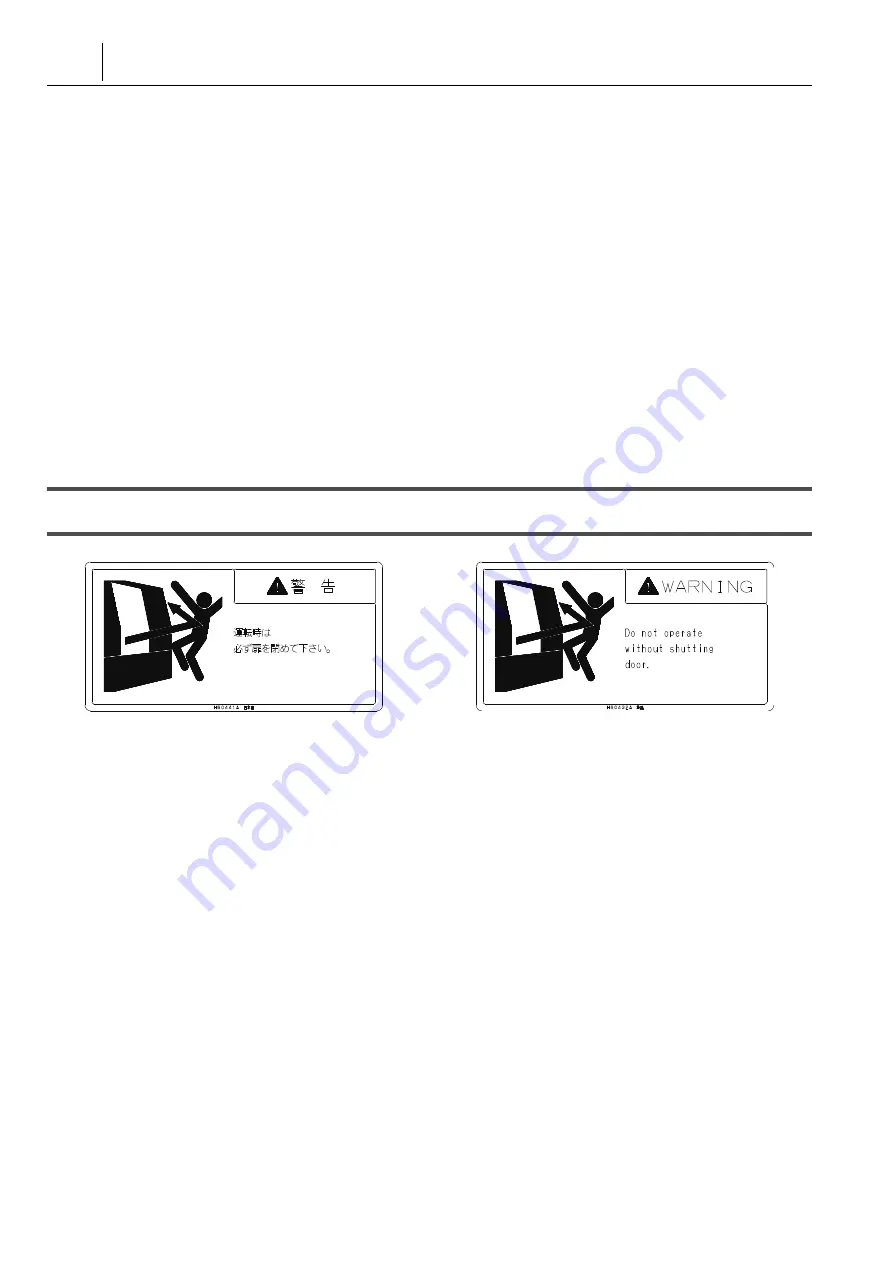
าᧇ
CAUTION LABELS
30
2.
˿ᢉوᢆ˹Ɂʋʭʍɹɗʹ˂ɹȾ᜔ȪǾͽഈᐐȟ˿ᢉȾ
ࢊȠᣅɑɟɞǿ
2.
The operator will become entangled with the spindle if the
operator touches the chuck or the workpiece while the
spindle is rotating.
3.
ᆬȾʹ˂ɹɥੰધȺȠȹȗȽȗৰȺ˿ᢉɥوᢆȨȮ
ȹǾʹ˂ɹȟ᭣ɆҋȬǿ
3.
A workpiece will fly out if the spindle starts while the
workpiece is not clamped correctly.
4.
ʡʷɺʳʪȾᩖᤏȗȟȕɝǾʹ˂ɹȻࡾщᴥҏ࿎իᴦȟᚗ
ሶȪǾʹ˂ɹɗྲǾࡾщȽȼȟ᭣ɆҋȬǿ
4.
A workpiece, chuck jaws, and tools will fly out if the tool (or
turret) collides with the workpiece due to a programming
error.
5.
ᤈ۾ȽҒҭӌɗᤕ॑ӌȾɛȶȹʋʭʍɹɁੰધӌȟͲ˩
ȪǾʹ˂ɹȟ᭣ɆҋȬǿ
5.
A workpiece will fly out due to lowered gripping force of
chuck caused by excessively heavy cutting force or
centrifugal force.
6.
ሉӦ˹ɗஉو˹Ɂҏ࿎իȾͽഈᐐȟɂȨɑɟȲɝǾࢊȠᣅ
ɑɟɞǿ
6.
The operator will be caught or entangled by moving parts
such as turret during axis feed or indexing motions.
7.
Ғҭ˹ɁҒɝȢȭȝɛɆɹ˂ʳʽʒȟ᭣ୠȪǾᄻȾоɞȽ
ȼͽഈᐐɗൡಽɁ֚ɝȾȗɞ̷ɁᡵͶȾԲɥ˫țɞǿ
7.
The operator or a person standing near the machine will be
splashed with chips and coolant during machining, resulting
in injury or health problems (particularly if chips or coolant
get into the eyes).
8.
ሜӦ˹ɁʋʍʡɽʽʣʮȾਖ਼ɗᠴȟ᜔ɟǾͽഈᐐȟʋʍʡ
ɽʽʣʮȾࢊȠᣅɑɟɞǿ
8.
The operator will become caught in the chip conveyor when
the operator's hand or foot touches the chip conveyor while
it is operating.
5-5
ൡಽᤆᢆ˹Ɂާпᴥ
1
ᴦ
Safety During Machine Operation (1)
1.
ൡಽᤆᢆ˹ɂඩᬂʓɬɥᩐɔȹȢȳȨȗǿ
ൡಽɁюϫɂԲ
᪙ȺȬǿ
1.
Keep the front door closed while the machine is operating.
The area inside the front door contains many sources of
potential danger.
•
ʹ˂ɹɥੰધȪȹᯚᣱوᢆȬɞ˿ᢉ
x
The spindle rotating at a high speed with a workpiece
clamped in it
•
ᛓୣɁҒҭࡾщɥȷȤȹوᢆȪȲɝǾҰऻࡿծȾሉӦȬ
ɞҏ࿎ի
x
The turret which rotates and moves in many directions
with a number of sharp cutting tools
•
᭣Ɇୠɞɹ˂ʳʽʒɗҒɝȢȭ
x
Splashing coolant and flying chips
2.
Ғҭӌɗᤕ॑ӌȾɛȶȹʹ˂ɹȟ᭣ɆҋȨȽȗɛșԚґȽ
ȷȞɒ͍ɥȻȶȹȢȳȨȗǿɑȲǾ॒ᛵȾख़ȫȹ॑ઃիɗ
ળɟඨɔȺୈધȪȹȢȳȨȗǿ
2.
Allow a sufficient chucking amount so that the workpiece
will not come out of the chuck due to the cutting force or
centrifugal force generated by spindle rotation. Support the
workpiece with the tailstock or the steady rest if necessary.
•
ʹ˂ɹɁᄽवȾߦȪȹᩋȨɁҾնȟ۾ȠȗکնɂǾʹ˂
ɹɁаብɥҭɞȻȠȾʹ˂ɹȟᣟȥɞɁɥ᩻ȣȲɔǾ॑
ઃիȺୈધȬɞǿ
x
If the length-to-diameter ratio of the workpiece is large,
support the workpiece using tailstock so that it will not be
bent while the front end of the workpiece is being cut.
•
ʋʭʍɹɁྲɂɶʉɁȽȗɕɁɥΈșǿ
x
There must be no play in the motion of the chuck jaw.
•
܀ȗᄠ˽್ɁᄠҭɝȽȼҒҭɥȬɞکնǾҒҭ
ȾᐔțीɞɛșȾʹ˂ɹɁብɥʋʭʍɹᬂȾᆬȾȕ
ȹɞǿ
x
When heavy cutting a thick as-forged bar, place the
workpiece end against the chuck face so that the
chucking force can sustain the load during cutting.
•
ᨃᣲǾᣲɁʹ˂ɹɁکնǾྲɥʹ˂ɹɁȠӺᥓȾն
ɢȮȹढȬɞǿ
ȕɞȗɂǾᠯᆕɁʞʽȟੜȴᣅɑɟȲ
ྲɥΈႊȬɞǿ
x
When chucking a cast or forged workpiece, shape the
jaws to the draft of the workpiece or use the jaws with
carbide pins.
•
ʋʭʍɹྲɁʃʒʷ˂ɹ˹܄ґȺʹ˂ɹɥੰધȬɞǿ
x
Clamp a workpiece in the chuck at the center of the
chuck jaw stroke.
Summary of Contents for NL1500/500
Page 8: ......
Page 9: ...CONTENTS FOR SAFE MACHINE OPERATION REGULAR MAINTENANCE TROUBLESHOOTING INDEX...
Page 10: ......
Page 19: ...FOR SAFE MACHINE OPERATION...
Page 50: ......
Page 51: ...1 1 CHAPTER 1 CHAPTER 1 REGULAR MAINTENANCE...
Page 167: ...2 2 CHAPTER 2 CHAPTER 2 TROUBLESHOOTING...
Page 181: ...181 ZERO POINT RETURN COMMAND ALARM TRIGGERED X X Axis Z Z Axis Y Y Axis...
Page 232: ......
Page 240: ......
Page 242: ......







































